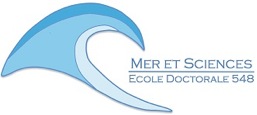Le Bureau des Études Doctorales a le plaisir de vous informer que
Madame Aurélie PORTAS
Doctorante au laboratoire MAPIEM
rattaché à l’École Doctorale 548 « Mer & Sciences » (France)
soutiendra sa thèse en vue de l’obtention du Grade de Docteur
sous la direction de
M. Jean-François BRIAND, Maitre de Conférences-HDR, Université de Toulon (France)
M. Gérald CULIOLI, Professeur des Universités, Université d’Avignon (France)
Co-encadrée par
Mme Nolwenn QUILLIEN, Chargée de recherche, France Énergies Marines-Plouzané (France)
Discipline : Physiologie et Biologie des organismes – Populations- Interactions
Spécialité : Écologie marine
sur le thème
« Biofouling dans le contexte des énergies marines renouvelables : étude des communautés procaryotes et eucaryotes et des paramètres physiques structurants »
Mercredi 12 avril 2023 à 09h00
A l’Université de Toulon – Campus La Garde Bâtiment M – Amphi M.01
devant un jury composé de :
- M. Cédric HUBAS, Professeur, Museum National d’Histoire Naturelle (France), Rapporteur
- Mme Frédérique VIARD, Directrice de Recherche, CNRS – ISEM Montpellier (France), Rapportrice
- Mme Agnès BOUCHEZ, Directrice de Recherche, INRAE-Thonon les Bains (France), Examinatrice
- M. Antoine CARLIER, Chargé de recherche, IFREMER Plouzané, (France), Examinateur
- Mme Nolwenn QUILLIEN, Chargée de recherche, France Energies Marines Plouzané (France), Co-encadrante de thèse
- M. Gérald CULIOLI, Professeur des Universités, Université d’Avignon (France), Codirecteur de thèse
- M. Jean-François BRIAND, Maitre de Conférences-HDR, Université de Toulon (France), Directeur de thèse
Résumé :
Le biofouling est un processus à l’origine de nombreux effets néfastes dans le domaine des énergies marines renouvelables (EMR) où les effets et l’ampleur de la biocolonisation sont encore méconnus. Dans le cadre du projet ABIOP+, l’objectif de cette thèse a été de mieux comprendre les mécanismes de colonisation spécifiques aux sites EMR. La diversité et la composition des communautés eucaryotes ont, dans un premier temps, été évaluées à travers différentes approches moléculaires afin de détecter la plus large gamme de taxons à partir d’échantillons collectés dans plusieurs milieux marins contrastés. Dans un second temps, cette thèse s’est intéressée aux facteurs influençant la dynamique de colonisation des communautés du biofouling, en particulier l’effet de l’hydrodynamisme. Une approche in situ et semi-contrôlée ont été réalisées en évaluant les réponses des communautés aux différentes conditions hydrodynamiques. Pour cela, une caractérisation multi-échelle des biofilms ainsi formés a été entreprise via des approches complémentaires liant métabarcoding (procaryotes et eucaryotes), métabolomique non ciblée, dosages biochimiques et microscopie. Enfin, nous avons étudié les communautés eucaryotes dans différents sites EMR en Atlantique et Méditerranée immergées entre 3 et 24 mois. Des mesures des caractéristiques générales du biofouling (biomasse, biovolume, densité, …) et des approches de taxonomie moléculaire ont révélé des différences dans les communautés eucaryotes.
Mots clés : biofouling, metabarcoding, hydrodynamisme, suivi spatio-temporel
Biofouling in the context of marine renewable energies: study of prokaryotic and eukaryotic communities and physical structuring parameters
Abstract:
Biofouling is a process at the origin of many adverse effects in the field of marine renewable energy (MRE) where the effects and extent of biocolonization are still unknown. Within the framework of the ABIOP+ project, the objective of this thesis was to better understand the colonization mechanisms specific to MRE sites. The diversity and composition of eukaryotic communities were first evaluated through different molecular approaches in order to detect the widest range of taxa from samples collected in several contrasting marine environments. Secondly, this thesis focused on the factors influencing the colonization dynamics of biofouling communities, in particular the effect of hydrodynamics. An in situ and semi-controlled approach was carried out by evaluating the responses of the communities to different hydrodynamic conditions. For this, a multi-scale characterization of the biofilms thus formed was undertaken via complementary approaches linking metabarcoding (prokaryotes and eukaryotes), non-targeted metabolomics, biochemical assays and microscopy. Finally, we studied the eukaryotic communities in different EMR sites in the Atlantic and Mediterranean submerged between 3 and 24 months. Measurements of general biofouling characteristics (biomass, biovolume, density, …) and molecular taxonomy approaches revealed differences in eukaryotic communities.
Keywords: biofouling, metabarcoding, hydrodynamics, spatio-temporal monitoring


